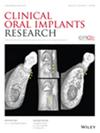Manufacturing and Application Precision Changes in Three-Dimensional Printed Surgical Guides for Dental Implants: An In Vitro Study
Abstract
Objectives
To assess the reproduction accuracy of a surgical guide during both the manufacturing phase (from designed files to manufactured surgical guides) and the application phase (from manufactured surgical guides to post-plasma sterilization) across four three-dimensional (3D) printing technologies.
Materials and Methods
Twenty-four surgical guides were designed and categorized into four groups (six surgical guides per group) based on the printing technology used: stereolithography apparatus (SLA), digital light processing (DLP), laser cladding deposition (LCD), and selective laser melting (SLM). The surgical guide files were collected in three conditions: design, post-printing, and post-plasma sterilization. The integrated precision, regional precision, and implant precision of the surgical guides were evaluated by measuring (1) T-vertex marker distance and angle, (2) surgical guide deformation after superimposition, and (3) implant 3D displacement.
Results
SLA printers exhibited the lowest reproduction accuracy and implant precision during the manufacturing phase (p < 0.001) and demonstrated the lowest implant precision during the application phase. In contrast, SLM printers displayed the highest reproduction accuracy and implant precision across both phases (p < 0.001). LCD printers showed slightly lower reproduction accuracy and implant precision than SLM during both the manufacturing and application phases.
Conclusion
SLM printers provide superior precision for implant surgery. Their use is recommended for printing surgical guides due to their high reproduction accuracy and implant precision during the manufacturing and application phases. In cases where SLM technology is unavailable, LCD printers offer a reliable alternative.

 求助内容:
求助内容: 应助结果提醒方式:
应助结果提醒方式:


